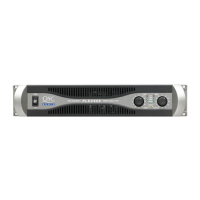Audio Power Stage, Current Limit Troubleshooting
CURRENT LIMITS WHICH COLLAPSE PREMATURELY.
An immediate collapse of ALL current limits at full power could be premature triggering of “Power Supply
Cutback”, which is described in the section below. Cutback after several seconds of full power operation at
two ohms is normal.
Cutback of one or more output sections, at full temperature, while approaching full power into two ohms is
also normal. However, cutbacks at 4 ohms, or when cold into two ohms, indicate problems with the
transistor power measuring circuitry.
CLAMPING VOLTAGES COLLAPSE TOO SOON.
CHANNEL-POLARITY
CH
I+
CH
l-
CH
2+
CH
2-
Measure voltage on:
c21
c22
C56
c57
Cuts back too easily: low value,
R67,
73
R68,
74
Rl90,
196
Rl91,
197
or high value:
R
51,
72
R53,
75
Rl74,
195
Rl76,
198
or missing diode:
D9
D8
D34
D33
CLAMPING VOLTAGES ARE CORRECT, CURRENT STILL WEAK.
Shorted diode
DIO,
14
Dll,
12
D35,
39
D36,
37
Missing-unsoldered output device or emitter resistor.
TROUBLESHOOTING “POWER SUPPLY CUTBACK”.
As noted in the section on Power Supply, the amplifier’s current limit cuts back when necessary to protect
the power supply. Because the Observed effect is a reduced output voltage, in response to prolonged
operation above the long-term current limit, we commonly refer to this behavior as “power supply cutback”,
but we must remember that it is actually
amp/Tier
current
hmifhg
in response to an overload signal sent
from the power supply. Full power operation into 2 ohms (both channels) should produce a 50% cutback of
current after several seconds.
If both channels of the amplifier fail to cut back after about 3 seconds, 2-ohms, both channels driven, the
cutback signal is probably missing. CAUTION: Prolonged operation under these conditions could blow
IGBT
or burn out
Cl44.
Test for 6-10 seconds maximum.
Check the output (secondary side) pins of U17 (sh 4). Confirm presence of
+6V
on pin
5.
Pin 4 should
normally be at about
OV,
and go high (I-5V) after 3 seconds at full power,
If
Ul7-pin
4 does not go high, check U17 itself. If it appears OK, trace the circuitry driving U17 (PRIMARY
SIDE, CAUTION). Check for continuity through
L6:2
to Pri-Lo, check missing or open
R343,
D61,
Q95,
R347,
all of which drive optocoupler U17. A short in R346 or Cl31 will also prevent drive to U17.
If
Ul7-pin
4 goes high on schedule, and BOTH channels fail to cut back, trace voltage on
“PS_OL”
bus to
R273 (sh
3),
which connects to “MUTE+” bus. Continue tracing voltage on MUTE+ to
Ql6
(sh I) and
Q61
(sh 2). If only ONE channel fails to cut back, look for missing
Ql6,
R 65,
Ql7
(sh I) or
Q61,
Rl88,
Q62
(sh 2).
Cl31 controls the speed of cutback.. If missing, the amplifier current limits will enter cutback almost
immediately at or above full power, 4 ohms.
SHORT CIRCUIT CURRENT DOESN’T CUT BACK.
CAUTION: DO NOT MAINTAIN A SHORTED LOAD IF CUTBACK FAILS TO OCCUR WITHIN 1 SECOND.
It will be necessary to measure the output current with a DC current probe, or by noting the voltage across
a low value resistance with a DC scope, in order to determine which output cell is failing to cut back.
Failure to cut back could indicate either lack of clamping, or lack of voltage cutback. Measure the voltage
on the respective clamp capacitor. If the voltage decreases, but current limiting does not cut back, check
the clamping transistor.
:
16

